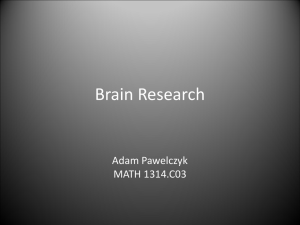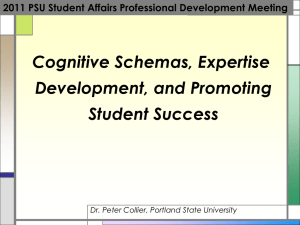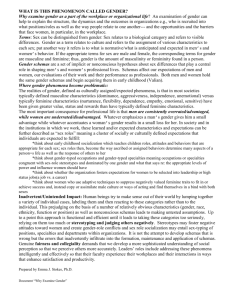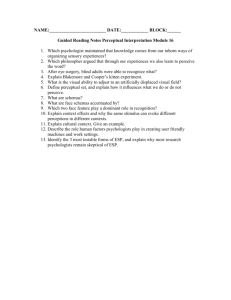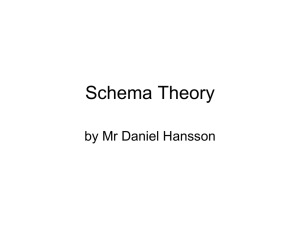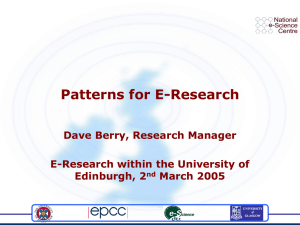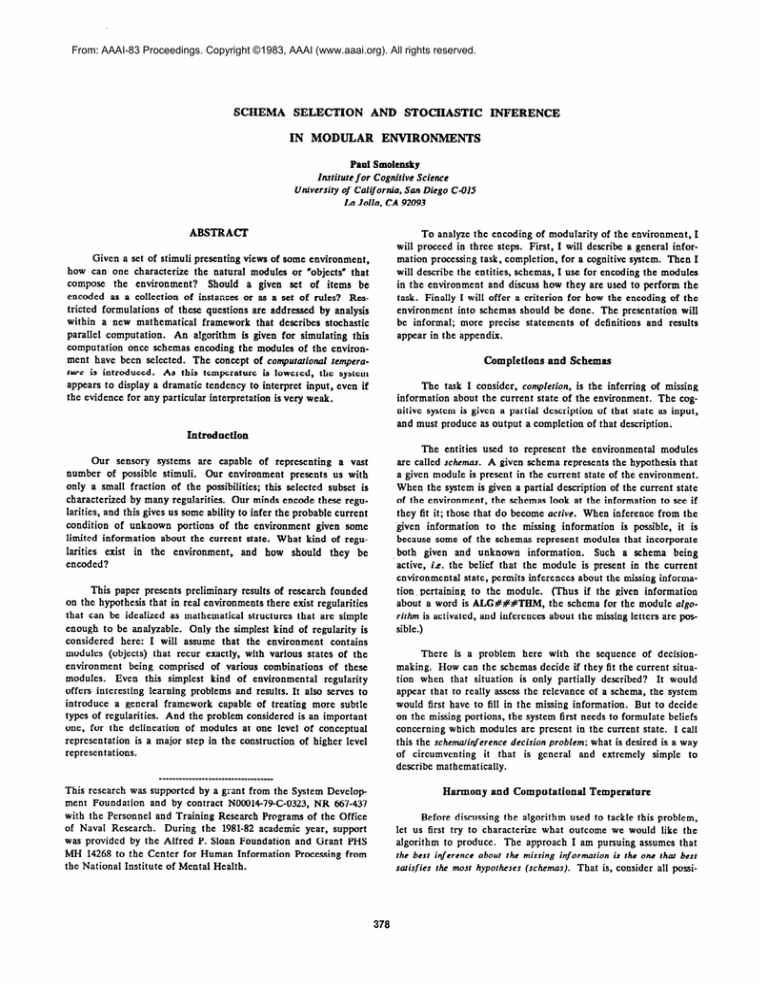
From: AAAI-83 Proceedings. Copyright ©1983, AAAI (www.aaai.org). All rights reserved.
SCHEMA SELECTION
IN MODULAR
AND STOCHASTIC
INFERENCE
ENVIRONMENTS
Paul Smolensky
Institute for Cognitive Science
University of California. San Diego C-015
La Jolla. CA 92093
AB!3TRAtX
To analyze the encoding of modukuity
of the environment,
I
will proceed in three steps. First, I will describe a genera1 information processing task, completion,
for a cognitive system. Then I
will describe the entities, schemas, I use for encoding the modules
in the environment
and discuss how they are used to perform the
task. FinaIly I will offer a criterion for how the encoding of the
environment
into schemas should be done. The presentation
will
be informal;
more precise statements
of definitions
and results
appear in the appendix.
Given a set of stimuli presenting views of some environment,
how can one characterize
the natural modules or “objects” that
compose
the environment?
Should
a given set of items be
encoded
as a collection
of instances or as a set of rules?
Restricted formulations
of these questions are addressed
by analysis
within a new mathematical
framework
that describes stochastic
parallel computation.
An algorithm
is given for simulating
this
computation
once schemas encoding the modules of the environment have been seIected.
The concept of computational temperature is introduced.
As this temperature
is Iowered, the system
appears to display a dramatic tendency to interpret
input, even if
the evidence for any particular interpretation
is very weak.
Completions
and Schemas
The task I consider,
completion, is the inferring of missing
information
about the current state of the environment.
The cognitive system is given a partial description
of tkat state as input,
and must produce as output a compIetion of that description.
IIltrodoction
The entities used to represent
the environmental
modules
are called schemas. A given schema represents the hypothesis that
a given module is present in the current state of the environment.
When the system is given a partial description
of the current state
of the environment,
the schemas look at the information
to see if
they fit it; those that do become active. When inference from the
given information
to the missing information
is possible, it is
because some of the schemas represent
moduIcs that incorporate
both given and unknown
information.
Such a schema being
active, i.e. the belief that the module is present in the current
environmental
state, permits inferences about the missing infotmation pertaining
to the module.
(Thus if the given information
about a word is ALG##fTHM,
the schema for the module algorithm is activated, and inferences
about the missing letters are possibIe.)
Our sensory
systems are capabIe of representing
a vast
number of possible stimuli.
Our environment
presents
us with
only a smaI1 fraction
of the possibilities;
this se&ted
subset is
characterized
by many regularities.
Our minds encode these regularities, and this gives us some ability to infer the probable current
condition
of unknown
portions of the environment
given some
Iimited information
about the current state. What kind of regularities
exist in the environment,
and how should
they be
encoded?
This paper presents preliminary
results of research founded
on the hypothesis that in real environments
there exist reguIarities
that can be idealized as mathematical
structures
that are simpIe
enough to be anaIyxabIe.
Only the simpIest kind of reguhuity
is
contains
considered
here: I will assume that the environment
modules (objects) that recur exactly, with various states of the
environment
being comprised
of various combinations
of these
modules.
Even this simplest kind of environmental
regularity
offers interesting
Iearning problems and results. It also serves to
introduce
a general framework
capable of treating
more subtle
types of regularities.
And the probIem considered is an important
one, for the delineation
of moduIes at one level of conceptual
representation
is a major step in the construction
of higher Ievel
representations.
There is a probIem
here with the sequence of decisionmaking.
How can the schemas decide if they fit the current situation when that situation
is onIy partially
described?
It wouId
appear that to really assess the relevance of a schema, the system
wouId first have to fill in the missing information.
But to decide
on the missing portions, the system first needs to formulate beliefs
concerning
which moduks
are present in the current state. I call
this the schema/inference decision problem; what is desired is a way
of circumventing
it that is general
and extremely
simple to
describe mathematicaIIy.
This research was supported
by a grant from the System Develop
ment Foundation
and by contract NO001679-C-0323,
NR 667-437
with the Personnel and Training Research Programs of the Office
of Naval Research.
During the 1981-82 academic year, support
was provided by the Alfred P. Sloan Foundation
and Grant PHS
MH 14268 to the Center for Human Information
Processing from
the National Institute of Mental Health.
Rarmony
and Compn tationd
Temperature
Before discussing the algorithm
used to tackle this problem,
Iet us first try to characterize
what outcome we would like the
algorithm
to produce.
The approach
I am pursuing assumes that
the best inference about the missing information is the one that best
sarisfies the most hypotheses (schcmas).
That is, consider all possi-
378
ble responses
of the system to an input (a partially
specified
environmentaI
state).
Each such response involves (a) a decision
about exactly which schemas are active, and (b) a decision about
how to specify all the missing information.
Given such a response,
‘I propose a measure of the internal consistency that computes the
degree to which the hypotheses represented
by the active sehemas
are satisfied by the input and output.
I call this measure the liarmony function H. Responses characterized
by greater internal consistency - greater harmony - are “better.” (The definition of H is
simple, but requires the formalism given in the appendix.)
the temperature,
the more random are the decisions, that is, the
more often the changes go “downhill.” Thus this algorithm,
unlike
strict hill-climbing,
does not get stuck at local maxima.
However,
there is a tradeoff.
The higher the temperature,
the faster the systern escapes local maxima by going downhill; but the higher the
temperature,
the more random is the motion and the more of the
time the system spends in states of low harmony.
EventuaIIy,
to
be quite sure the system’s response has high harmony,
the temperature must be low.
proceeds, the optimization
point of this
As the computation
tradeoff
shifts. InitiaIIy, the guesses for the missing information
are completely
random, so the information
on which schemas are
determining
their relevance is unreliable.
It is therefore
desireable to have considerable
randomness
in the decision making, i.e.
high temperature.
Even at high temperature,
however, the system
is more likely to occupy states of higher harmony than lower, so
the guesses become more reliable than their completely
random
start. At this point it makes sense for the schemas to bc somewhat
less random in their activity decisions, so the temperature
should
be lowered a bit. This causes the system to spend more of its time
in states of higher harmony, justifying a further decrease in temperature.
And so the temperature
should be gradually lowered to
achieve the desired final condition of low temperature.
(A centraI
concern of future work is analysis of how to regulate the cooling
of the system.)
Given that better responses are characterized
by greater harmony, the obvious thing to do is hill-climb in harmony.
However
this method is apt to get stuck at local maxima that are not global
maxima.
We therefore
temporarily
relax our desire to go directly
for the “best” response.
Instead we consider a stochastic system
that gives different
responses
with different
probabilities:
the
better the response, the more likely the system is to give it. The
degree of spread in the probability
distribution
is denoted T; for
high values of T, the distribution
is widely spread, with the better
responses being only slightly more likely than Iess good ones; for
low values of T, the best response is much more likely than the
others. Thus T measures the “randomness”
in the system; I call it
the computational
temperature.
When
we want
only good
responses, we must achieve low temperature.
A general stochastic algorithm
can be derived that realizes
this probabilistic
response;
it provides
a method
for computer
simulation.
A parallel relaxation
method is used to resolve the
schema/inference
decision problem
in a way that involves no
sophisticated
control.
proceeds and the temperature
drops, the
As the computation
response becomes progressystem’s initially rough and scattered
sively more accurate and consistent.
This is just the kind of computation
typical in people and just the kind needed in any large
parallel system, where each subsystem needs a constant stream of
input from the others.
The variables
of the system Fe the activations
of aI the
schemas (1 = active, 0 = inactive) and the bits of missing information. The system starts with (a) all schemas inactive, and (b) completely random guesses for all bits of missing information.
Then
randomly
a schema or a bit of missing information
is selected as
the variable to be inspected; it will be now be assigned a (possibly
new) value of 1 or 0. Using the current guesses for all the other
variables, the harmony
function is evaluated
for the two possible
states of the selected variable.
These two numbers,
H(1) and
H(O), measure the overall consistency for the two cases where the
selected
variable
is assigned
1 and 0; they can be computed
because
tentative
guesses have been made for all the schema
activations
and missing information.
Next a random
choice of
these 1,0 states is made, with the probability of the choices 1 and 0
having
ratio
$$.
(Th e reason
for the exponential
function
Cognitive
As computation
proceeds, does accuracy increase slowly and
steadily, or does the system undergo sudden and dramatic changes
in behavior, as do physical systems when they are cooled past critical temperatures
marking
phase transitions?
This question has
been addressed
both through
computer
simulation
and analytic
approximation
of a two-choice decision.
The system has two schemas representing
conflicting
interpretations
of the environment.
The approximate
theory allows computation
of the probabilities
of
various
completions
given an input that partly
describes
the
environment.
It is useful to ask, what is the completion of a completely ambiguous input? For high temperatures,
as one might
the completions
form random
mixtures
of the two
expect,
interpretations;
the system does not choose either interpretation.
below a certain “freezing temperature: the system adopts
However,
one of the interpretations.
Each interpretation
is equally likely to
be selected.
The computer simulation approximates
this behavior;
below the freezing point, it dips back and forth between the two
interpretations,
occupying each for a long time.
is
given in the appendix.)
This random process - pick a schema or bit of missing information; evaluate the two harmonies;
pick a state - is iterated.
In
the theoretical
limit that the process continues indefinitely,
it can
be proved that the probability
that the system gives any response is
proportional
to eHfl, where H is the harmony of that response.
This probability
distribution
satisfies the qualitative
description
of
response probabilities
we set out to realize.
Cooling
Crystakation
Slowly vacillating
interpretation
of genuinely
ambiguous
input is a familiar but not particularly
important feature of human
cognition.
What is significant here is that even when the input provides no help whatever in selecting an interpretation, the system eventually (when cooled sufficiently) abandons meaningless mixtures of
interpretations
and adopts some coherent interpretation.
A robust
tendency
to form coherent
interpretations
is important
both for
modelling human cognition
and for building intelligent machines.
The above analysis suggests that in processing typical inputs, which
the System
In this algorithm,
each schema activation
or bit of missing
information
is determined
randomly;
most likely the value with
higher harmony is chosen, but sometimes not. Thus most of the
time the changes raise the harmony, but not always. The higher
379
This result can be abstracted
from the reading context in
which it was presented for expository convenience;
the mathematical result does not depend upon the interpretation
we place upon
the modules with which it deals. Thus the result can be characterNatural schemas encoding tk modules of an
ized more abstractly:
environment are inducible by tk training harmony criterion, provided
the modules
recur
exactly.
This investigation
must now be
extended
to cases in which the recurrence
of the modules is in
some sense approximate.
are at most partially
as processing
continues
and the
ambiguous,
randomly
through
temperature
the system wanders
an
drops,
ever-narrowing
range of approximate
solutions
until some time
when the system freezes into an answer.
Schema
Selection
Having discussed how schemas are used to do completions, it
is time to consider
what set of schemas ought to be used to
represent the regularities
in a given environment.
Suppose the systern experiences
a set of states of the environment
and from these
it must choose its schemas. Call these states the training set. Since
the schemas are used to try to construct high-harmony
responses, a
reasonable
criterion
would seem to be: tk best schemas are those
that permit tk greatest total harmony for responses to tk training
set.
Roles
When should experience
be encoded as a list of instances
and when as a collection of rules? To address this issue we consider two environments
that are special subsets of the four-Ietter
environment
considered
above:
I call this the training harmony criterion. I will not here discuss an algorithm
for finding the best schemas.
Instead, I shall
present some elementary
but non-obvious
implications
of this very
simple criterion.
To explore these implications,
we create various
idealized environments
displaying interesting
modularity.
Choosing a training set from within this environment,
we see whether
the training
harmony
criterion
allows the system to induce tk
modularity from the training set, by choosing schemas that encode
the modularity.
Perceptoal
vs. Instances
FAMB
FAND
FARP
FALT
Environment R
VEiUB SIMB
VEND SIND
VERP SIRP
VELT SILT
ZOMB
ZOND
ZORP
ZOLT
FARB
FENP
FIMT
FOLD
Environment I
VAMP SALT
VELB SEiUD
VIRD SINB
VONT SORP
ZAND
ZERT
ZILP
ZOMB
In the highly regular environment
R, there are strict rules such as
“F is always followed by A”; in the irregular
environment
I, no
such rules exist.
Note that here, schemas for the “rules” of
environment
R are just digraph schemas: FA-, VE-, .... -RP. -LT;
schemas for “instances” are whole-word schemas.
Grouping
We perceive sceneS not as wholes, nor as vast collections of
visual features, but as collections of objects. Is there some general
characterization
of what is natural about the particular
levels of
grouping
that
form
these “objects”?
This question
can be
addressed at a simple but abstract level by considering
an environment of strings of four letters in some fixed font. In this idealized
environment,
the modules
(“objects”) are letter tokens, and in
various states of the environment
they recur exactly: each letter
always appears in exactly the same form. The location of each of
the four letters is absolutely fixed; I call the location of the first
letter the “first slot,” and so forth. The environment
consists of aI
combinations
of four letters.
One might hope that a criterion for schema selection would
dictate
that environment
R be encoded
in digraph
schemas
representing
the rules while environment
I be encoded in word
schemas
representing
instances.
Tk training harmony criterion
implies that for the regular environment, digraph sckmas are better
than word schemas; for tk irregular environment, it is tk reverse.
(In each case the entire environment
is taken as the training set.)
Higher
Now consider a computer given a subset of these four-letter
strings as training;
call these the training words. The image the
computer
gets of each training word is just a string of bits, each
bit representing
whether some portion of the image is on or off.
The machine does not know that “bit 42” and “bit 67” represent
adjacent
places; a11 bits are spatially
meaningless.
Could the
machine possibly induce from the training that certain bits “go
together” in determining
the “first letter”, say? (These, we know,
represent
the first slot.) Is there some sense in which schemas for
the letter A in the first slot, and so on, are natural encodings of
this environment?
Level Analyses
The framework
described here is capable of addressing more
sophisticated
learning
issues. In particular,
it is well-suited
to
analyzing the construction
of higher-level representations
and conthe value of hierarchical
organization
sidering,
for example,
(which is not put into the system, but may come out in appropriate environments.)
In addition
to addressing
issues of schema
selection at the more perceptual
levels considered here, the framework can be employed at higher conceptual
levels. The selection
of temporal scripts, for example, can be considered,
by taking the
environment
to be a collection
of temporally
extended episodes.
The simulation
method
described
here for systems with given
schemas can also be applied at higher levels; it is being explored,
for example, for use in text comprehension.
As an obvious alternative,
for example, the system could simPIY create one schema for each training - word. Or it could create a
schema for each bit in the image. These are the two extreme cases
of maximally big and small schemas; the letter schemas fall somewhere in between.
Which of these three cases is best?
Tk
training harmony criterion implies that letter schemas are best, provided the training set and number of bits per letter are not too
small.
ACKNOWLEDGEMENTS
I am indebted
to George Mandler and Donald Norman for
the opportunity
to pursue this work.
Geoffrey
Hinton, James
McClelland,
David Rumelhart,
and the members of the UCSD
380
The probability
of any response
(A,B) is a monotonically
,increasing function f of its harmony H (A ,B). f is constrained
by
the following observations.
If p1 and pz are not connected - even
base IJ, then inferences about
indirectly - through the knowledge
p1 should be statistically independent of those about p2. In that
case, H is the sum of the harmony
contributed
by three sets of
to p2. and those
schemas: those connected
to pl, those connected
connected
to neither.
The desired
statistical
independence
requires that the individual probabiIities
of responses for p1 and p2
multiply together.
Thus f must be a function that takes additive
harmonies
into multiplicative
probabilities.
The only continuous
functions
that do this are the exponential
functions,
a class that
can be parametrized
by a single parameter
T ; thus
Parallel Distributed
Processing
research
group have contributed
enormously
to the perspective
on cognition taken in this work. I
am grateful to Francis Crick, Mary Ann McCrary, Michael Mozer
and Donald Norman for extremely helpful comments on the paper.
Above all, warm thanks go to Douglas Hofstadter
for his continual
encouragement;
the inguence of his ideas pervades this research.
APPENDIX:
The Formal
Framework
of Harmony
Theory
In the following general discussion, the specifics of the fourletter grouping environment
discussed in the text are presented in
parentheses.
The possible beliefs B of the cognitive
system about the
current state of the environment
forms a space 5. This space is
assumed to have a set p of binary coordinates
p; every belief B is
defined by a set of bits B(p) in {+1,-l},
one for each p s p. (Each
p represents
a distinct pixel. B(p) is +l if the system believes p is
on, -1 if off. This belief can come from inference or input.) An
input I to the system is a set of binary values I(p) for some of the p
E up; an output
is a set of binary values 0 (p) for the remaining p.
Together, I and 0 form a complete belief state B, a completion of 1.
A schema S is defined by a value S(p)
e p. (If pixel p does not lie in the first slot,
letter A in the first slot” has S(p) = 0. If
slot, then S(p) is + 1 according to whether
If for some particular p, S (p)# 0, then that
the number of arguments
of S is denoted
schema, every p is an argument.)
prob(A J?) = n en(Aa)/r
The normalization
constant n is chosen so that the probabilities
for all possible responses add up to one. T must be positive in
order that the probabihty
increase with H . As T approaches zero,
the discontinuous
function that assigns
the function f approaches
equal nonxero probability
to maximal harmony responses and zero
probability
to all others.
CE{ +l,-1,0} for each p
the schema S for “the
p does lie in the first
the pixel is on or off.)
p is an argument of S;
I S I. (For a word
Considerations
similar to those of the previous paragraph
lead in thermal physics to an isomorphic
formula (the Boltzmann
law) relating the probability
of a physical state to its energy. The
randomness
parameter
there is ordinary
temperature,
and I therefore caI1 T the computational temperature of the cognitive system.
The probability of a completion B is simply the probability of
all possible responses
(A,B) that combine
the beliefs B with
schema activations A: prob(B) = n CA eH(Aa)/r.
Schemas are used by the system to infer likely states of the
environment.
For a given environment,
some schemas should be
absent, others present,
with possibly varying relative strengths
corresponding
to varying
likelihood
in the environment.
A
knowledge base for the system is a function u that defines the relative strengths
of all possible schemas: u(S) zz 0 and
a(S) = 1.
Monte carlo analyses of systems in thermal physics have proven quite successful (Binder, 1976). Starting from the exponential
probabiIity
distribution
given
above,
the stochastic
process
described in the text can be derived (as in Smolensky, 1981). The
above formula for H leads to a simple form for the stochastic
decision aigorithm of the text that supports the following interpretation.
The variables
can be represented
as a network
of “p
nodes” each carrying value OCp), “S nodes” each carrying value
A(S), and undirected
links from each p to each S carrying label
a(S) - S@) (links labelled zero can be omitted).
The nodes
represent
stochastic
processors
running
in parallel,
continually
transmitting
their values over the links and asynchronously
setting
their values, each using only the IabeIs on the links attached to it
and the vaIues from other nodes transmitted
over those links.
This representation
makes contact with the neurally-inspired
“connectivist” approach to cognition and parallel computation
(Hinton
and Anderson,
1981; McClelland and Rumelhart,
1981; Rumelhart
and McClelland,
1982). Independently
of the development
of harmony theory, Hinton and Sejnowski (1983) developed
a closely
to stochastic
parallel
networks
following
related
approach
(Hop field, 1982) and (Kirkpatrick,
Gelatt,
and Vecchi,
1983).
From a nonconnectionist
artificial intelligence
perspective,
Hofstadter (1983) is pursuing a related approach to perceptual
group
ing; his ideas have been inspirational
for my work (Hofstadter,
1979).
(The knowledge
bases relevant
to the text have all a(S) = 0
except for the schemas in some set S - like letters - for which the
strengths
are a11 equal.
These strengths,
then, are all l/#S,
the
inverse of the number of schemas in the set.)
A response of the system to an input I is a pair (A a), where
B is a completion
of I, and A defines the schema activations:
A(S) E {O,l} for each schema S .
A harmony function H is a function that assigns a real number
H,(A,B)
to a response
(A,B), given a knowledge
base u, and
obeys certain properties
to be discussed elsewhere.
A particular
exemplar is
H,(AJ)
= ~4)A(S)
s
B(p)S(p)
- KI S I
I
Here K is a constant in the interval [O,l]; it regulates what proportion E of a schema’s arguments
must disagree with the beliefs in
order for the harmony resulting from activating that schema to be
negative: e = %.(l-K). In the following we assume z to be small
and positive.
(The terms without K make H simply the sum over
all active schemas of the strength of the schema times the number
of bits of belief (pixels) that are consistent with the schema minus
the number that are inconsistent.
Then each active schema incurs
a cost proportional
to its number of arguments,
where K is the
constant of proportionality.)
An environment for the cognitive system is a probability
distribution
on 5. (All patterns of on/off pixels corresponding
to
sequences
of four letters are equally probable; all other patterns
have probability
zero.) A training set T from this environment
is a
sample of points T drawn from the distribution.
(Each T is a
381
training
word.) A responw
A of the system
to the set T is a
specification
of schema activations A(T) for each T. The training
harmony of such a response is BI,(A,T) = CT H,(A(T),T).
The
maximum of H,(A,T) over all responses A is H,(T), the training
harmony permitted by the knowledge base u .
Each of the sets of schemas considered
in the text (Ietters,
digraphs,
. ..) tile the training set T, in that each T agrees exactly
with schemas
that have nonoverIapping
arguments
and that
together cover all of T. AII results cited in the text folIow from
this elementary
calculation:
If the knowledge buw cr consists of a
set of schemas S tlrat tile T, then H,(T) = const./#S
where const. is
u con.rtunt Ior a given T. Thus given a single training set T and
two tilings of T with sets of schemas, the set with fewer schemas
permits greater training harmony, and is preferred
by the training
harmony criterion.
If the number of letters in the alphabet u is
smaller than the number of pixels per letter, letters are a better
encoding than pixels; if the number of training words exceeds 4a
then letters are better than words. The number of word schemas
needed in the restricted environments
R and I is 16; the number of
digraphs needed for R is 8 while for I it is 96.
The calculation
cited in the previous paragraph
is quite simple. Recall that if the proportion
of a schema’s arguments
that
disagree with the beliefs exceeds Q, then the harmony
resulting
from activating that schema is negative.
Thus if E is chosen smaI1
enough (which we assume), then for any given training word T,
only those schemas that match exactly can contribute
positive harmony. In the response A(T) that maximizes the harmony,
therefore, only exactly matching schemas will be active; the others will
be inactive, contributing
zero harmony.
Since the schemas S tile
T, for each pixel p in T there is exactIy one active schema with p
as an argument,
and the value B(p) of the pixel is consistent with
that schema, so B(p )S(p) = 1. Thus
~~p)~[B(pp@)
s
P
- d s(p)11
= #p(i-K)
where
const.
= const ./# S
= &# p# T, which is constant
of Phase Transitions
and
Binder, K. “Monte Carlo Investigations
Critical Phenomena.”
In Domb, C. and M. S. Green (&Is.), Phuse
Transitions and Critical Phenomena, vol. Sb. New York: Academic
Press, 1976.
Hopfield, J. J., “Neural networks and physical systems with emergent cohective computational
abilities.” Proc. National Academy of
Sciences USA 79 (1982) 2554-2558.
Hinton, G. E. and J. A. Anderson
HiIIsdaIe,
NJ:
ciative Memory.
1981.
(Eds.). Purullel Models of AssoLawrence
ErIbaum
Associates,
Hinton, G. E. and T. J. Sejnowski, “Analyzing Cooperative
Computation”
in Proceedings of the Fifth Annul Coqference of the
Cognitive Science Society. Rochester, New York, May, 1983.
Hinton, G. E. and T. J. Sejnowski, “Optimal Perceptual
Inference,”
to appear in Proc. IEEE Conference on Computer Vision and Pattern
Recognition. Washington,
D.C., June, 1983.
Hofstadter,
New York:
D. R. Godel, Escher, Bach: an Eternal Golden
Basic Books, 1979. Chapters X, XVI and XIX.
Hofstadter,
D. R., “The Architecture
of Jumbo,” to appear
Proc. Machine Learning Workshop, Illinois, June, 1983.
in
Kirkpatrick,
S., C. D. Gelatt and M. P. Vecchi, “Optimization
Simulated Annealing.”
Science 220:4598 (1983) 671-680.
by
McClelland,
J. L. and D. E. Rumelhart,
“An interactive activation
model of context effects in letter perception,
Part 1: An account
of the basic findings.” Psychological Review 88 (1981) 375407.
= #p-26
Because a(S) is a constant for a11 S c S, the harmony H,(A(T),T)
is simply
the
previous
expression
times
a(S) = l/# S, or
&# p/#S.
Since this quantity is identical for aI1 training words
T, summing over aI1 T in the training set T just multiplies this by
the size of T, giving 2e# p# T/# S as the training harmony permitted by u:
H,(T)
REFERENCES
for a given T.
Rumelhart,
D. E. and J. L. McClelland,
“An interactive activation
model of context effects in letter perception,
Part 2: The contextual enhancement
effect and some tests and extensions
of the
model.” Psychological Review 89 (1982) 60-94.
Smolensky,
dissertation
P. Lattice Renormalization
of 44 Theory.
Physics Dept ., Indiana University, 1981.
Doctoral

